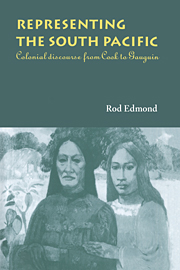Book contents
- Frontmatter
- Contents
- List of illustrations
- Acknowledgements
- 1 Introduction
- 2 Killing the god: the afterlife of Cook's death
- 3 Mutineers and beachcombers
- 4 Missionary endeavours
- 5 Trade and adventure
- 6 Taking up with kanakas: Robert Louis Stevenson and the Pacific
- 7 Skin and bones: Jack London's diseased Pacific
- 8 The French Pacific
- 9 Epilogue
- Notes
- Index
8 - The French Pacific
Published online by Cambridge University Press: 31 October 2009
- Frontmatter
- Contents
- List of illustrations
- Acknowledgements
- 1 Introduction
- 2 Killing the god: the afterlife of Cook's death
- 3 Mutineers and beachcombers
- 4 Missionary endeavours
- 5 Trade and adventure
- 6 Taking up with kanakas: Robert Louis Stevenson and the Pacific
- 7 Skin and bones: Jack London's diseased Pacific
- 8 The French Pacific
- 9 Epilogue
- Notes
- Index
Summary
On 5 May 1772 Marion du Fresne sailed into the Bay of Islands, on the east coast of New Zealand's North Island, to a friendly welcome. This capacious bay with its deep inlets and scattered islands had been visited by Cook's Endeavour in 1769, and Anne Salmond remarks that the welcome was no doubt influenced by memories of the Endeavour's muskets and cannon fire, ‘which made trade more tempting than attack’.Regular trading followed, a masting camp was established on shore and a hospital camp for sick crew was set up on one of the islands. Both French and Maori sources agree that relations between the inhabitants and their visitors were excellent.
Marion was soon convinced of the benevolence and sincerity of the local people. He was predisposed to believe this, being familiar with the myth of Tahiti as Nouvelle Cythére, and having almost certainly talked with Commerson, Bougainville's botanist, who had done most to propagate it. Some months earlier in Tasmania he had sent two of his men ashore naked to allay the fears of the Aboriginals by showing that, skin colour apart, the French were like themselves. This sensible and imaginative approach to achieving rapport also marked his contact with the inhabitants of the Bay of Islands, where Marion seems to have thought he had discovered a noble version of the Tahitian bon sauvage.
- Type
- Chapter
- Information
- Representing the South PacificColonial Discourse from Cook to Gauguin, pp. 223 - 264Publisher: Cambridge University PressPrint publication year: 1997

